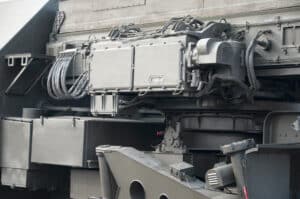
Following proper stainless steel specifications and guidelines are necessary to ensure the integrity of any application and fully function as designed, be it a fitting, fastener, or structural component, during the product’s intended service life. This is particularly important regarding applications manufactured for military use. Stainless steel is a material used widely in the defense and aerospace industries because, when correctly specified, it meets the operational requirements needed to perform in diverse environments and settings.
Overall, stainless steel’s many favorable properties contribute significantly as a material choice in manufacturing parts and components for use in military applications such as aircraft, land vehicles, marine vessels, missiles, and a variety of equipment.
There are many grades and types of stainless steel, but all are iron-based alloys, including chromium, carbon, and other elements such as nickel, manganese, molybdenum, silicon, and titanium. A minimum of 10.5 % chromium provides stainless steel’s corrosion-resistant properties. The chromium composition of stainless steel makes it approximately 200 times more resistant to corrosion than steels without chromium.
More than providing corrosion resistance, stainless steel is also noted for its low-temperature resistance, high tensile strength and durability, easy formability and fabrication, low maintenance, and long service life. Some stainless steels also hold non-magnetic properties, an important design characteristic in certain defense and aerospace applications.
Stainless steel specifications are determined by the material’s crystal microstructure’s grade and unique metallurgical characteristics. Among the latter are families of stainless steel, with austenitic, ferritic, duplex, and martensitic the most prevalent. Among the former is the grading system that separates one type of stainless steel from another. With over 150 grades, many stainless sheets of steel share similar characteristics. However, the nearly endless combination of alloying metals and elements differentiates one grade from another. Yet, of these many available grades, only a dozen or so have the desirable properties for military applications.
Grades Used in Military Applications
Austenitic stainless steel grades in the 300 series are non-magnetic and meet military specifications for many applications. Grades 304, the 316 series (316L, 316H, and 316Ti alloys), and grade 321 all offer excellent resistance to general and pitting corrosion. Despite the similarities, there are subtle differences in grades. For example, Type 321 is a stabilized austenitic stainless steel similar to Type 304 but is alloyed with titanium and at least five times the carbon content. Ideal for use at elevated temperatures, grade 321 applications include high-temperature tempering equipment, diesel and heavy-duty automotive exhaust systems, firewalls, and jet aircraft components.
Typical uses for grades in the 300 series include applications for exhaust manifolds, jet aircraft components and jet engine parts, and components exposed to marine environments. A “super-austenitic” stainless alloy, AL-6XN, is a seawater-resistant material that has since been adapted for use in various applications in corrosive environments. Duplex stainless steel, grade 17-4 PH, is a versatile, martensitic precipitation-hardening material used in propeller shafts, gear wheels, bearing, bolts, spindles, and foils, deck platforms, and turbine blades.
Aerospace and Defense Applications of Stainless Steel
Stainless steel’s properties make it an ideal, if not indispensable, material for aerospace and defense industries. Stainless steel material is used to manufacture parts and components of aircraft, including engine parts, landing gear, and structural components. Due to its high tensile strength, durability, and high-temperature resistance, stainless steel is used to produce missile components. Its corrosion-resistant properties make it ideal for use in harsh marine environments. Its high strength-to-weight ratio makes it an ideal material for military vehicles and aircraft armor plating. It’s also used to manufacture pressure containers for storing and transporting liquids and gases and to produce various tooling and fixtures for use in aerospace and defense applications.
Atlantic Stainless supplies the widest variety of high-quality stainless steel and high-temperature alloy products combined with unmatched services. We recognize that meeting stainless steel specifications is not just required but critical for military applications. Our stainless steel products adhere to and meet all military specifications required for defense and aerospace applications. For more information, contact us today.

